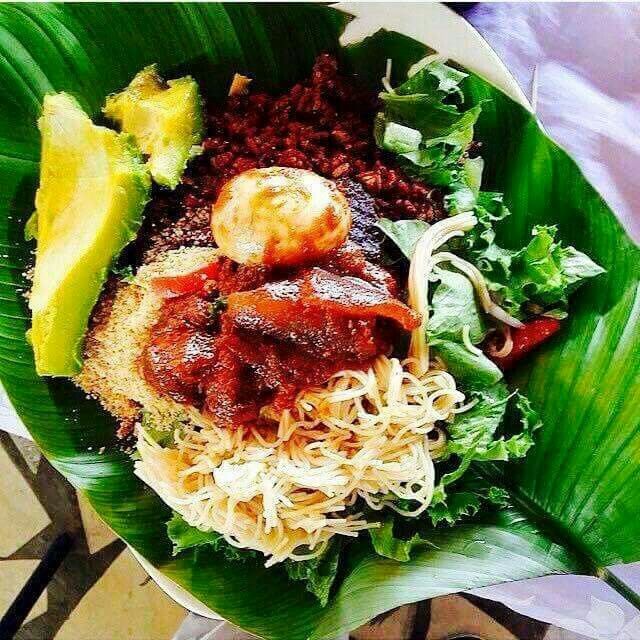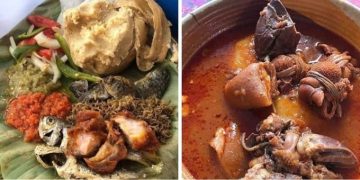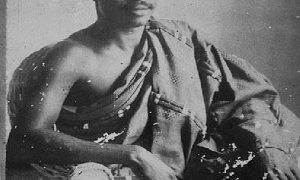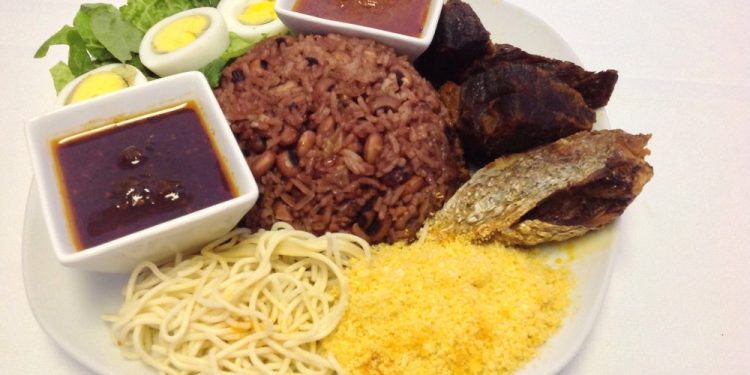Jollof is not Ghana’s only hype dish, the country is blessed with a lot of local dishes. Prominent amongst them are Fufu and soup, Banku and okro stew or soup, Ga Kenkey with hot pepper and fish, Fante Kenkey, Eto, Amnesia with palaver sauce, gari and beans, waakye, Tuo Zaafi. The taste of all these meals are worth hustling for, one dish is however rapidly making waves just as Jollof did.
Waakye or Awaakye is a dish eaten in every Ghanaian community. It was previously peculiar to people of the north but has now risen to become a principal dish in and beyond Ghana, after the famous Jollof rice. From observation, one out of five people in Ghana eats waakye at least once during the week. This makes the dish worth placing on a pedestal. It can be eaten at any time of the day- morning, afternoon and evening. Due to its prominence in Ghana, there are usually crowds of people queued up at the stalls of Waakye vendors hoping to enjoy this sumptuous meal.
Waakye is prepared with a combination of beans, rice and some herbs. The result gained from this combination brings out an exotic taste that one will not savour when the rice and beans are cooked separately. The herbs give Waakye a reddish brown colour when the meal is dished. Depending on the consumer’s preference, it can be soft and compacted or loose. Each community has its own style of cooking and serving the meal. The dish is usually served in leaves or disposable bowls based on the consumer’s preference.
An interesting fact in eating waakye is that its accompaniments and side dishes can be eaten separately as a main meal. As such, the meal is usually accompanied with shito, stew, fish, egg, salad, slices of pear, wele, gari, talia, fish, fried plantain and beef. The number of accompaniment and side dishes eaten with this meal is not the most eye-catching reason for the high patronage the meal, there are some funny names given to the accompaniments. These are called the waakye terminologies, every waakye lover knows these terms, for example, many people refer to spaghetti as ‘talia’, and cowhide as ‘wele’ or ‘kahuro’ when they purchase waakye.
Why has waakye gained prominence in Ghana? First, the popularity of this dish comes from its exquisite taste. A blend of tastes from the assorted accompaniments added to the dish is enough to drive a person to patronize this dish. The taste is so unique that a spoonful of this meal is enough to make a person’s toes curl. Waakye is indeed a delight to the heart. The aroma that comes from the dish also leaves less to be desired. “Waakye can rouse an unconscious person,” one lady happily said. “The aroma of waakye can overpower the scent from a smelly gutter,” another joked. If you’re not a waakye lover, these testimonies of its taste should convince you to try it more often.
Another reason for its popularity is its accessibility in Ghanaian communities. You can find a waakye vendor in every community. In fact, it can be said that there are more waakye vendors than Jollof vendors. The vendors are so many that, it’s difficult to go into a community and see less than five waakye vendors. The ingredients of the dish are also readily available to people who wish to cook it at home. Also, the relative of the meal is the charm. The dish is not only geographically accessible but also financially accessible. The meal is eaten by people from all walks of life- upper class, middle class and lower class. The average price of the dish hovers around GHc 4.50 which encouraging considering its exquisite taste. Thus with GHc 5.00, you can eat to your heart’s content and still save some coins.

Health benefits of Waakye
The reasons for which waakye is popular have been recounted. There are other important benefits of waakye that is worth hailing. The dish when prepared and served under the most hygienic conditions would give a person more than enough value for money. First and foremost, waakye provides the body with fibre. The fibre, in turn, improves the body’s metabolism. The dish also fuels the body to function effectively. A plate of waakye will give you the boost and energy to start the day. These benefits stem from the high level of carbohydrates present in waakye; main from gari, spaghetti, rice.
The dish is also filling and satisfying. Two servings of waakye can sustain an average person through the morning and the afternoon. The beans and meat in the dish delay the onset of hunger and prevents overeating. The combination of rice and beans also makes waakye ideal for most vegans. The beans provide the bodybuilding mechanism in place of meat. Furthermore, the consumption of beans has been associated with decreased levels of cardiovascular malfunction. Thus, regular waakye consumers need not fear the perils of heart-related problems.
Other benefits of eating waakye include reduced carcinogenic action in the body, improved skin care, Obesity and diabetes prevention, vision enhancement. All these benefits can be derived if the ingredients are combined in their appropriate quantities.
Waakye is indeed worth the hype because it has all these inherent advantages. The taste, health benefits make the dish worth consuming. To those who have not tried the dish, please try it but make sure you don’t bite your tongue out of excitement.
Foodie Question
1. What is the name given to leaves used in colouring waakye?



















































